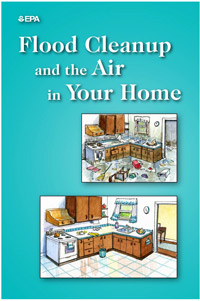Private Well Water | Public Drinking Water Supplies | Links for More Info
Following extensive flooding in some areas of Tompkins County in the wake of the storms of June 14, 2015, the Tompkins County Health Department (TCHD) advises county residents whose private water well supplies have been impacted by the storms to take appropriate precautions to ensure their water is safe.
Private Well Water
If the area around a private well has been flooded or there is any suspicion or risk that the well has been contaminated from flood waters, consumers are advised to stop drinking, cooking, brushing teeth and bathing with the well water and disinfect the well. Wells in flooded areas may be contaminated with waterborne germs that can cause serious illness. Until the well has been properly disinfected and tested, water used for these purposes should be disinfected as mentioned below or bottled water should be used.
Warning signs that a well may be unsafe include: debris, mud or water and mud stains that indicate the well was flooded; erosion or instability in the ground surface around the well; damage to the well casing; a loose well cap; unusual odor, taste or appearance of the well water; or any visible electrical wires or components.
If the well has been or is suspected of being flooded, the well pump should not be turned on until the well has been thoroughly assessed and repaired as needed by a plumber or other well professional. Beware of electrical shock if your basement or electrical system has been flooded. Also, no one should drink, bathe, brush teeth or cook with well water after a flood until the well has been restored by proper disinfection and flushing. Unless there is indication that the well has been impacted by spilled fuels, oil or other chemicals, then it should be safe to continue to use water for flushing toilets.
Until the well is properly disinfected, bottled water should be used for washing, drinking or cooking. Tap water can be used if it has been disinfected by one of the following methods:
- Disinfection by boiling the water – This method produces the safest water. Bring the water to a rolling boil and maintain a full boil for one minute. After cooling, it is recommended that oxygen be restored to the water by pouring it back and forth between two containers – this will also improve the taste.
- Disinfection with Iodine or Chlorine tablets – First, check the expiration of the tablets before using and then follow package directions. One tablet is usually sufficient for one quart of water; double the dose if the water is cloudy.
For more information on disinfecting contaminated water, click here to download a PDF document from the NYS Department of Health.
Disinfecting a Well
A New York State Department of Environmental Conservation (DEC) registered well driller can be contacted for information about disinfecting your well and additional treatment if needed. For do-it-your-selfers, information about disinfecting a well, including step-by-step instructions, can be found by clicking here to download a PDF document from the NYS Department of Health.
After a well has been properly disinfected and chlorine has been flushed out of the water system, the water should be tested for bacteriological contamination. A list of labs that have been certified for drinking water testing can be found at the Wadsworth Lab web site. Scroll down the page to find Tompkins County listings.
Continue to disinfect any water used for drinking or food preparation, or use bottled water until sampling has shown the water to be safe and free of contamination. You should consider retesting your well several weeks after flooding since groundwater contamination after a flood may impact the well.
Public Drinking Water Supplies
TCHD officials and water suppliers are aware that turbidity levels are significantly higher than normal in some of the County’s municipalities as a result of yesterday’s storm, and that contamination by untreated sewage is present in many of the impacted waterways. Water suppliers are taking appropriate steps to ensure that the water is adequately treated, such as monitoring more frequently, increasing chemical treatment, and ensuring adequate filtration. Drinking water utilities (community water systems) are required to follow specific regulations and procedures to ensure water is safe for consumption and use and these requirements continue to be in full effect during the aftermath of the storm.
Drinking water utilities in Tompkins County are required to monitor water quality levels for a variety of man-made chemicals, naturally-occurring contaminants, physical characteristics and microbial pathogens and immediately report any public health hazards or emergency conditions to TCHD. The utilities will work with TCHD to identify and initiate an appropriate response action, and must notify TCHD of any changes in conditions until the problem is resolved.
Xem thêm thông tin
The following links to websites provide additional advice for dealing with the aftermath of flooding:
Flooding Quick Reference Guide: What to do before, during, and after a flood (PDF, 3-fold brochure)
House Cleanup Resources
 EPA booklet: Flood Cleanup and the Air in Your Home
EPA booklet: Flood Cleanup and the Air in Your Home- Floodsafety.com property cleanup
- YouTube video from the Univ. of Minnesota
What To Do With Wells After Floods
Being prepared before the storm hits is also important. Visit Don't Be Left in the Dark: Weathering floods, storms, and power outages on the NYS Department of Health web site. You can also download a PDF booklet there.

